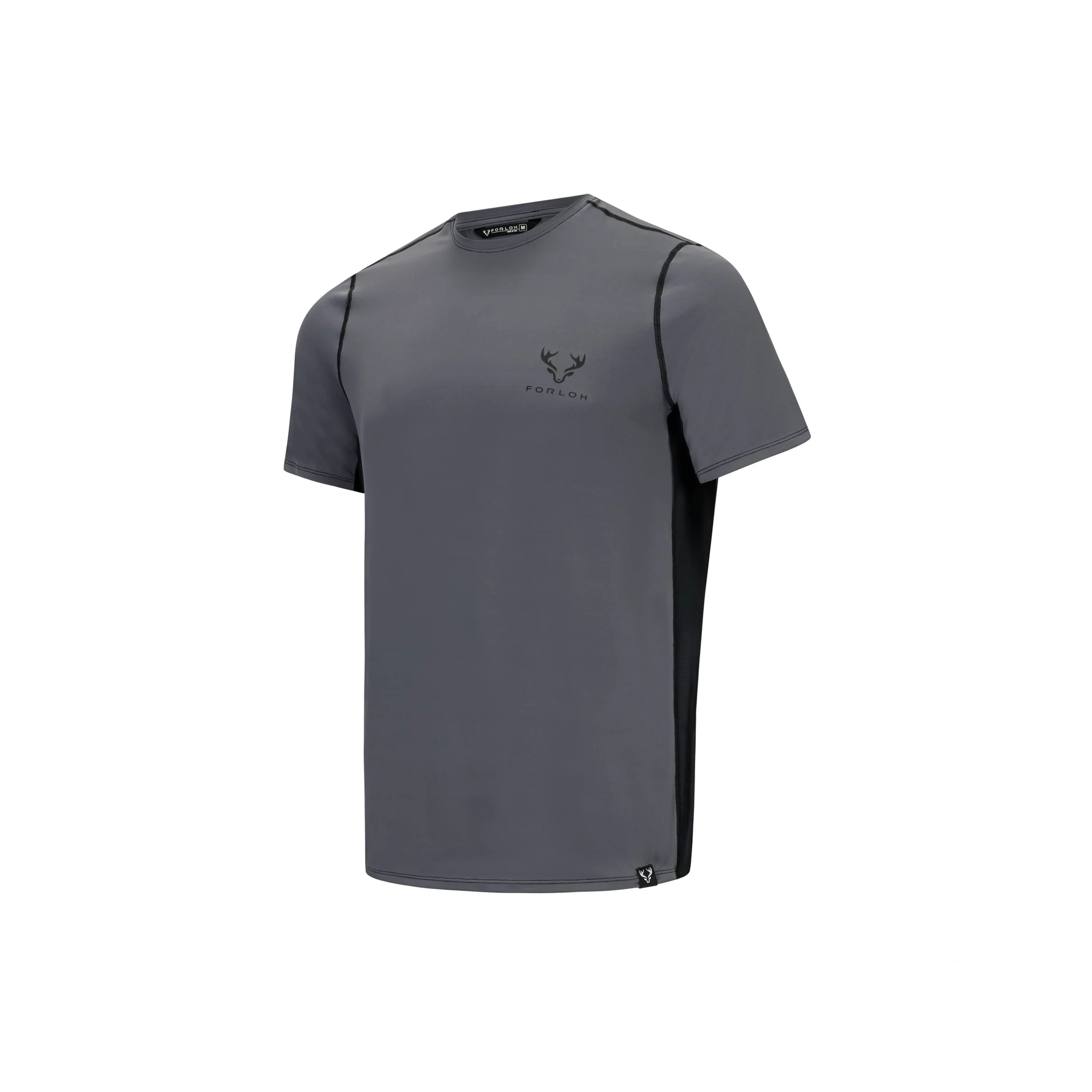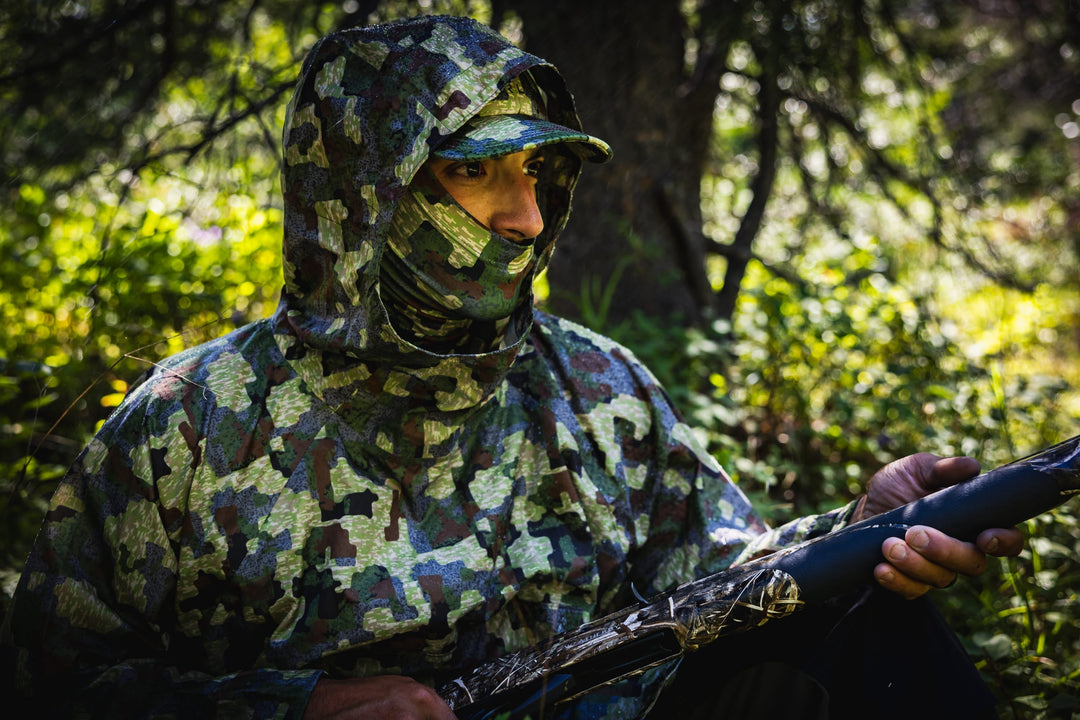When it comes to choosing the right hunting camo patterns, there's a lot to consider. Just like animals use their natural camouflage to hide or disguise themselves from prey, different types of camo patterns can help you stay concealed. Wearing camouflage clothing gives hunters the ability to blend into their surroundings and go undetected without scaring away their game.
Taking inspiration from the natural world, different types of camo have been developed to mimic specific environments and avoid detection by the animals who inhabit those environments. Below, we’ll cover the variety of hunting camouflage patterns and how to choose the best one for your pursuit.
|
Table of Contents |
Why Hunters Wear Camo
The evolution of hunting camouflage is a union of military innovation and a growing understanding of animal perception. Before modern camo, hunters relied on the red-and-black "buffalo check" pattern, which appeared gray to colorblind game animals yet remained visible to other hunters. Later, during World War I, military jungle camouflage patterns became available to hunters through army surplus stores.
It wasn’t until the 1980s that "stick-and-leaf" camo patterns became available, offering realistic designs tailored to various landscapes. This development coincided with improvements in hunting apparel, as sportswear companies began incorporating these patterns into their gear.
Today, effective camo hunting clothes are intended to break up the hunter’s silhouette, drawing inspiration from animal camouflage strategies: concealing coloration, disruptive coloration, disguise, and mimicry. However, it's important to note that animals perceive camo differently than humans. Most game animals have limited color vision but are highly sensitive to movement, depth, and brightness. Waterfowl, for example, possess superior eyesight and can detect even slight environmental inconsistencies.
Understanding these principles and the specific visual capabilities of target game animals is key to selecting the most effective camouflage for hunting success.

Different Types of Camo
There are several different types of camo on the market. Hunting camouflage falls into three main categories: traditional (based on military designs), 3D or leafy (realistic environmental patterns), and digital (pixelated designs developed using scientific imagery analysis). Some modern patterns combine elements from multiple categories for enhanced effectiveness.
Traditional Camo
Rooted in military use, traditional camouflage incorporates patterns designed to mimic specific natural environments, incorporating recognizable elements like branches, grass, and rocks. The designs often feature intricate shading to create a three-dimensional effect, enhancing depth perception. Color schemes typically include earthy tones such as tan, gray, brown, and black.
3D or Leafy Camo
This is one of the most common types of camouflage available. As its name implies, 3D or leafy camo uses technology to reproduce images of leaves, tree limbs, brush, and other foliage. With the employment of photorealistic illustrations, leafy camo is available in a variety of options to mimic any environment or condition.
3D camo is a reliable yet versatile pattern if you like to hunt diverse prey, but is especially useful for hunting highly perceptive animals like waterfowl.
Digital Camo
A more recent innovation, digital camo represents a departure from naturalistic patterns. Originally developed for military use, this style has gained traction in the world of hunting gear and clothing. Digital camo consists of pixelated graphics rather than representations of natural elements.
The primary goal of digital camo is to blur the wearer's outline, making it difficult for game to distinguish a human form from the landscape. Proponents of digital camo argue that it's particularly effective at concealing movement, which can be crucial when stalking wary prey.
Despite its modern appearance, digital camo employs a similar color palette to traditional patterns, utilizing variations of tan, gray, brown, and black.
Hunting Camouflage Patterns
Depending on where you’re hunting, different hunting camouflage patterns should be used to cater to the environment. Let’s look at some of these patterns and what makes the best hunting camo for different types of terrain.
Woodland and Waterfowl Camo
- Characteristics: Darker hues, with an absence of blaze orange
- Ideal Environments: Forests (below treeline), marshes, and wetlands
- Types of Game: Birds, such as ducks and other waterfowl
- Recommended Camo Pattern: FORLOH Deep Cover Camo
- Key Features: Deep Cover’s darker hues are intended for use in heavy canopy and help you disappear at 40 yards or less. This is an ideal choice for bowhunters where you must go undetected in close proximity.

Upland Camo
- Characteristics: Minimal patterns with blaze orange components to make you visible in open spaces
- Ideal Environments: Forests (above treeline), desert plains, tundra, and other open spaces
- Types of Game: Upland birds, such as pheasants
- Recommended Camo Pattern: FORLOH Exposed Camo
- Key Features: The Exposed camo pattern makes you virtually invisible at 75 yards or more, blurring your form into the landscape at a distance to avoid detection. Great in later seasons, at higher altitudes, and in barren landscapes.

Snow Camo
- Characteristics: Multiple white tones with brown accents to mimic dead grass or snow-covered rock
- Ideal Environments: Snowy conditions and ice fishing
- Types of Game: Waterfowl and fish (ice fishing)
- Recommended Camo Pattern: FORLOH Snowfall Camo
- Key Features: The subtle, disruptive coloration of our Snowfall camo keeps the eye tracking across the wearer, even for animals with full color vision.

Fishing Camo
- Characteristics: Subtle, disruptive coloration that allows the fisherman to blend in with the sky
- Ideal Environments: Saltwater, freshwater, and clear skies
- Types of Game: Fish
- Recommended Camo Pattern: FORLOH Sea Clear Camo
- Key Features: Since fish see in color, the subtle, disruptive coloration used in our Sea Clear camo makes it difficult for fish to detect.

Choosing the Right Camo Pattern
Unlike some types of clothing, choosing the right hunting camo is not a one-size-fits-all decision. Several environmental factors should guide your choice, including foliage color and density, hunting setup, and season.
Seasonal changes in foliage color significantly impact camouflage effectiveness. Spring and summer hunts typically call for greener patterns, while fall hunts benefit from brown-dominant designs that mimic the changing leaves. The amount of foliage also matters; dense forests may require leaf-patterned camo, while sparser areas might call for tree bark-inspired designs.
Your hunting setup is another critical consideration. Hunters using ground blinds might opt for darker patterns to blend with the interior shadows, while tree stand hunters should choose patterns that match the surrounding canopy.
However, the pattern is just one aspect of effective hunting gear. The quality and functionality of the clothing are equally important. Consider the specific needs of your hunt when selecting gear. For big game hunting, which can involve extreme temperature variations and diverse terrains, prioritize comfortable, quiet materials. Opt for brushed surfaces that mimic natural sounds like rustling leaves.
Ultimately, the best camo pattern and gear combination will depend on your specific hunting environment—season, terrain, and vegetation. But don’t neglect your personal needs or your target game and how well they can see.

Best Hunting Camo Clothing and Gear
Effective hunting camo ensures that the wearer will blend seamlessly into their natural surroundings, making them virtually undetectable. While most camouflage patterns aim to conceal the human form by mimicking the colors and patterns of the environment, our approach at FORLOH takes it a step further. We've developed a scientifically-driven method inspired by how animals perceive the world.
Our research started with how an animal’s visual system receives signals. In just seconds, animals will detect movement, acquire the image responsible for that movement, and then make reactive decisions based on the color or recognition of that image, the stimuli. For example, they will analyze whether the stimuli are natural (eyes) or non-natural (straight lines like zippers or glass frames). It is in these few seconds of fight or flight that FORLOH’s innovative camouflage excels, making its wearer indistinguishable from their environment.
Our camouflage patterns incorporate a high-contrast, large-scale pattern to disrupt the outline of the wearer, and introduce digital "texture" patterns that render them extremely difficult for prey to detect. This advanced approach to hunting camo ensures unparalleled concealment in the wilderness.
Essential Hunting Camo Apparel
The types of garments you choose can improve your concealment and your chances for a successful hunt. Hunting camo patterns are a necessity for clothing and outerwear when you want to be undetectable on a hunt. From head to toe, FORLOH clothing and hunting accessories will help you stay concealed.
Shop Jackets | Shop Pants | Shop Hats
Camo Hunting Gear and Accessories
Whether you’re hunting waterfowl in a forested marsh or fishing on a freshwater lake, our gear has you covered so you can focus on your pursuit. Browse FORLOH camo hunting gear and accessories for your next great adventure.
Shop Hunting Packs | Shop Neck & Boot Gaiters | Shop Shooting Accessories
Hunting Camo FAQ
What is the best camo pattern for hunting in the woods?
The best camo pattern for woodland hunting is typically a pattern that mimics the colors and textures of forest environments, such as green, brown, and black.
Can I use the same camo pattern in different environments?
While some camo patterns are versatile and can be used in multiple environments, it’s generally best to match your camo to the specific terrain and vegetation where you’ll be hunting. Specialized patterns provide better concealment.
Is it necessary to wear camo for all types of hunting?
While camo is highly beneficial for many types of hunting, especially when stalking or ambushing game, or bowhunting at close proximity, it may not be as crucial for other types, such as waterfowl hunting from a blind. Always consider the specific requirements of your hunting activity.
How do I maintain the effectiveness of my camo clothing?
To maintain the effectiveness of camo clothing, wash hunting clothes in scent-free detergent, avoid using fabric softeners, and store it in a scent-free bag or container. Repair any rips or tears promptly to preserve the pattern.
Do camo patterns really make a difference in hunting success?
Yes, camo patterns can significantly impact hunting success by helping hunters blend into their surroundings and avoid detection by game. Effective camouflage can reduce movement visibility and make it easier to get closer to animals.
Can animals see camouflage?
Animals can see camouflage, but their perception of it is different from that of humans when it comes to color vision, pattern recognition, and UV sensitivity. While animals can see camo, the effectiveness of camouflage depends on how well it matches the environment and how it takes advantage of the animals' specific visual capabilities and limitations. Using appropriate camo patterns can significantly enhance a hunter's ability to remain undetected.
Are there camo patterns designed specifically for women or children?
Yes, many camo brands offer patterns and clothing designed specifically for women and children, with adjusted sizing and fit to ensure comfort and effectiveness in the field. FORLOH Women’s Apparel is designed by women for a female-specific fit and uses our effective camouflage patterns. The FORLOH Youth Collection offers hunting clothes for kids made with the same advanced technology as our adult apparel.








